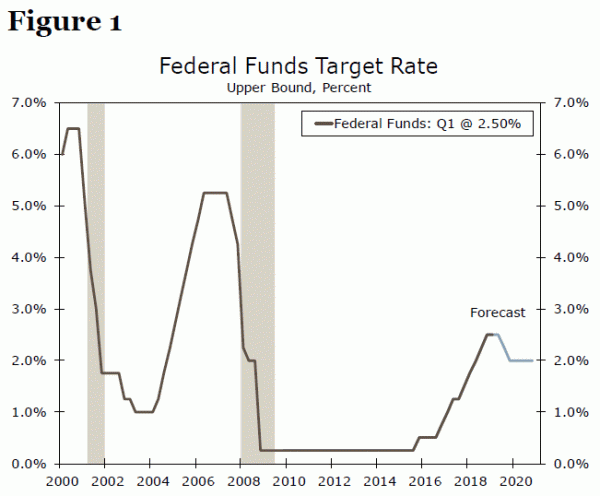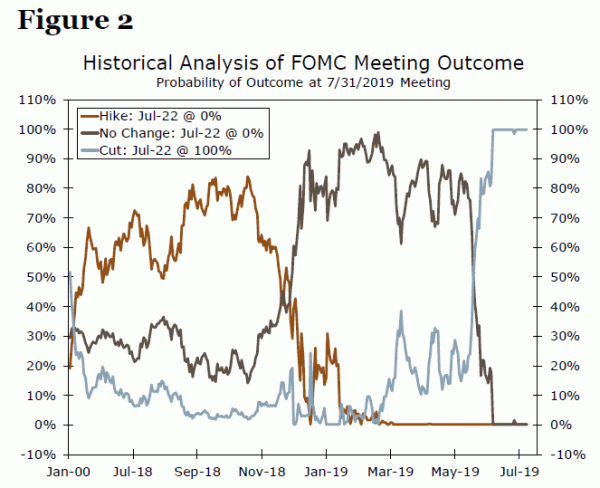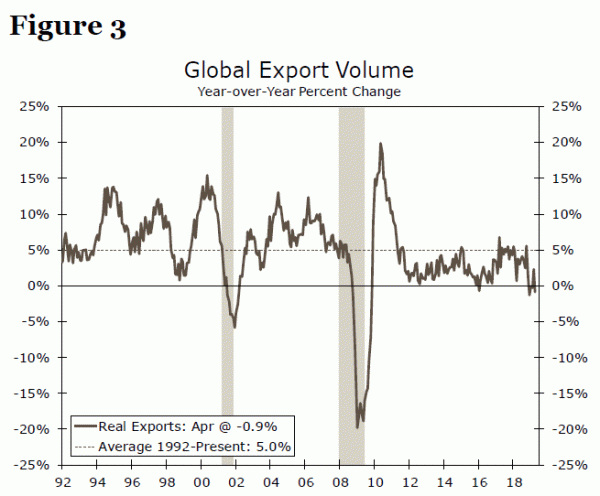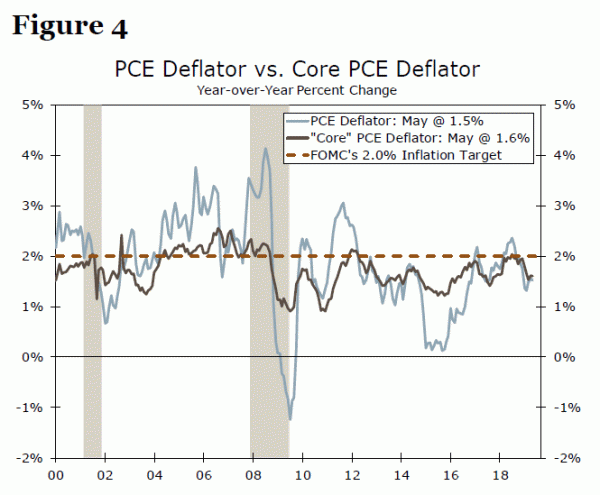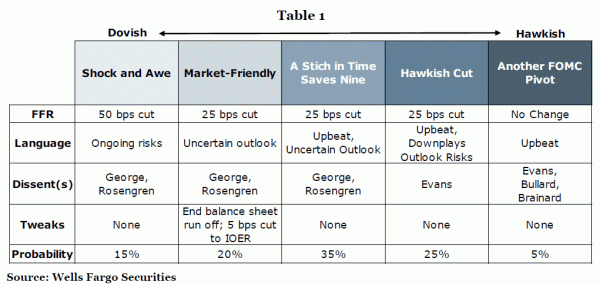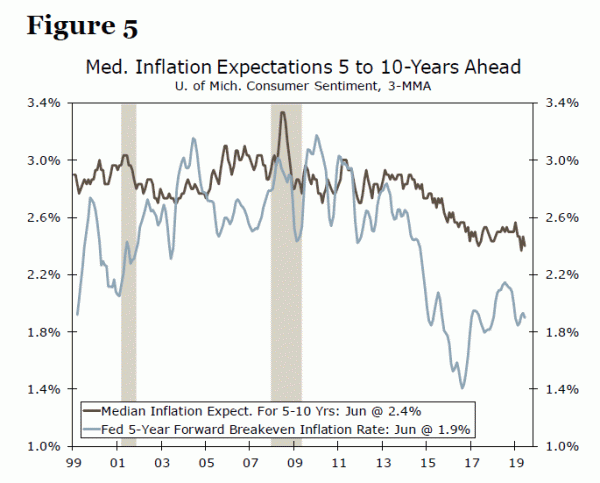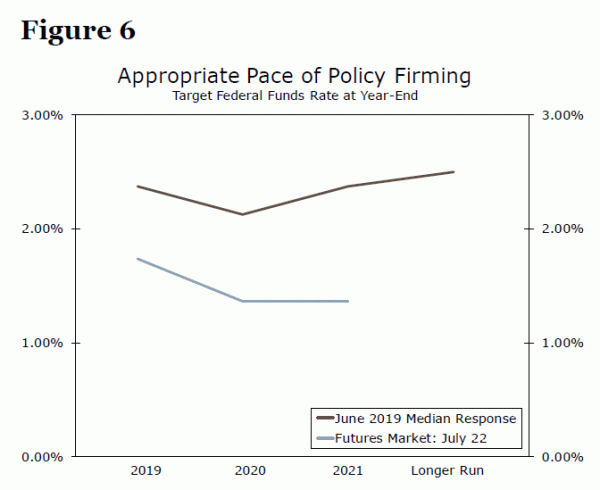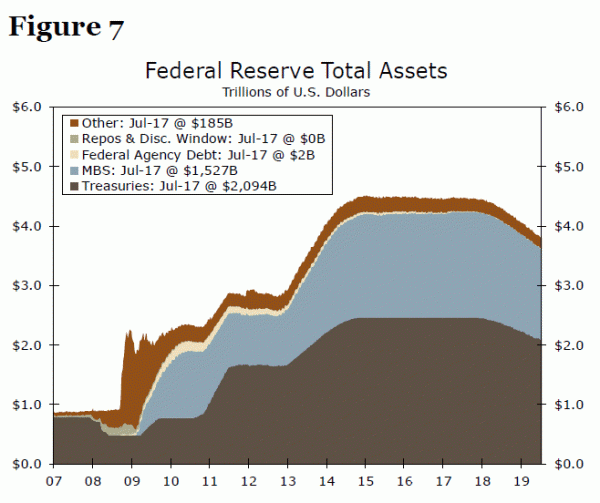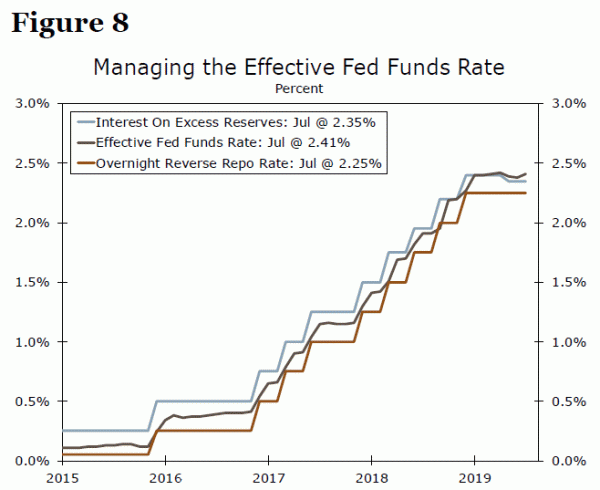At its meeting next week, the FOMC is expected to do something it has not done in over a decade: cut the fed funds rate. Despite a spurt of better-than-expected economic data, policymakers at recent public appearances, particularly Fed Chairman Jerome Powell, have done little to dial-back expectations for a cut. We have now entered the blackout period, that time in the immediate lead-up to the FOMC meeting when officials refrain from commenting on monetary policy. The most likely outcome in our view is that the FOMC will cut the fed funds rate 25 bps, emphasizing risks to the outlook from global growth and trade policy as well as stubbornly low inflation. In this report, we shine some light on what is driving that call as well as other possible scenarios and the probability of those outcomes.
Remind Me Again Why We’re Doing This?
Imagine for a moment you did not keep up with what the Federal Open Market Committee (FOMC) was saying and instead just looked at the data independently in an effort to anticipate the committee’s next move. Keeping in mind that the Fed is tasked with promoting maximum employment while maintaining price stability, you might reasonably conclude that the current state of policy is the perfect elixir for achieving both mandates with fairly agreeable results in the economy and financial markets. Face it: we are amidst the longest equity bull market, inflation is under control and unemployment is near its lowest rate since we first landed a man on the moon. Consumer spending is on track to post a 4-handle for its growth rate in the second quarter. Does it feel like easier monetary policy is the most appropriate policy response at this moment?
As recently as last autumn, guidance indicated the upward stairway for rates had at least a few more floors to go. Financial markets had some doubts about the pace of tightening, but expectations were still well-anchored in terms of direction. As recently as November, financial markets baked in an 80% probability that that the Fed would have hiked again by July (Figure 2). By January, all bets were off with markets banking instead on the FOMC remaining on hold. By May, thanks to jawboning by some Fed officials, it has become a lock that the FOMC will cut in July.
So What Changed?
During the dot-com boom and subsequent bust, there were questions about whether the Fed had some culpability in inflating the bubble in tech stocks by not tightening faster to rein in the “irrational exuberance” that was evident to the Fed at the time. What might posterity say about an FOMC that cuts interest rates with the unemployment rate at a near-record low and the stock market at a near-record high? At the risk of oversimplification: because the global economy is showing signs of serious strain amid the ongoing trade war, and inflation has been too low for too long.
Let’s take the global environment first. Figure 3 plots the year-over-year growth in global export volumes. Observe that over the past 30 years, it takes a U.S. recession to make global trade growth go negative. Yet, here we are in negative territory—an anomaly absent a U.S. recession for at least a generation. It may not be part of its mandate, but the Fed is paying attention to this cut-and-dry evidence that global trade is drying up. Trade tensions are at the heart of the pullback in global growth, and the FOMC fears the impact here at home, particularly as it relates to confidence and investment. In his testimony before Congress earlier this month, Chairman Powell made five separate references to deteriorating global growth in his opening remarks before taking questions.
As for inflation, the task of eventually hitting the Fed’s 2% target on a sustained basis is getting harder with every monthly shortfall. True, the pace has picked up more recently after a few one-off factors early in the year, increasing at a 2.0% annualized pace the past three months. But fear is rising that the sub-2% trend shown in Figure 4 is becoming entrenched, as inflation expectations hover near-record lows. Low inflation would not be the worst thing if nominal interest rates were higher, but it further hinders the FOMC’s ability to cut real rates come the next recession with nominal rates also low—an issue the Fed is thinking about intently as it undergoes its current review of policy, strategies and tools.
Suffice it to say, the FOMC is therefore in the unenviable position of loosening policy despite a soaring equity market and a labor market that is arguably overheating. More so than at any time since the height of the financial crisis, the FOMC faces a daunting challenge of delivering on the expected accommodation without overshooting and engendering the next crisis or falling short in terms of forward-guidance and undoing the benefit of a rate cut. Against that confounding backdrop, we now offer our take on some of the various policy options available to the Fed and handicap the probability of each scenario, beginning with the most likely to occur.
Scenario I: A Stich in Time Saves Nine
- Fed funds rate: 25 bps cut
- Language: More upbeat on recent activity, but notes uncertainty and risks to the outlook persist, while inflation remains muted
- Dissent(s): George (Kansas City), Rosengren (Boston)
- Other Tweaks: None—balance sheet normalization continues as planned, no changes to IOER
- Probability: 35%
The most likely outcome of the upcoming meeting in our view, and therefore our baseline call, is that the FOMC will cut rates by 25 bps. The statement will likely upgrade the recent performance of the economy to “solid” (as it was described as recently as May), as consumer spending has picked up more convincingly and job growth has rebounded. However, the statement and Chairman Powell in his press conference are expected to emphasize the continued risks and uncertainties the global trade environment presents to the outlook.
In light of those risks, the FOMC will likely deem it prudent to offer additional accommodation as part of a risk-management approach to policy. Given the limited space to cut the fed funds rate this cycle, the premise of this move would be to get out ahead of any meaningful slowdown in growth that could bring the expansion to an end. In addition, we expect to see the continued run of belowtarget inflation and the need to shore-up inflation expectations relayed as another reason for easier policy despite a generally strong economy (Figure 5). The door would remain open for additional cuts in the next few months.
The number and direction of dissents will be telling as to how much the Committee is coalescing around this “risk-management” approach. We would not be surprised to see a dissent from Kansas City Fed President Esther George and Boston Fed President Eric Rosengren in this scenario as each has been skeptical of additional accommodation at this time.
Scenario II: The Hawkish Cut
- Fed Funds Rate: 25 bps cut
- Language: More upbeat on recent activity, downplays risks to the outlook
- Dissent(s): President Evans (Chicago)
- Other Tweaks: None
- Probability: 25%
Words matter. In this scenario, the FOMC proceeds with the nearly universal expectation to cut the fed funds rate, but re-asserts control over expectations going forward. Since the committee’s last rate move (a 25 bps hike in December), it has struggled to manage the expectations of financial markets. Case in point, the futures market suggests a greater than 60% probability that the Fed will cut at least three times in the second half of 2019. Chances of two or even one more cut this year would look much less likely, however, with a “hawkish cut”.
What might this look like? In the statement, the assessment of recent activity generally and consumer spending specifically would be upgraded along the lines of our baseline case. “Uncertainties” in the outlook would be used to justify the meeting’s cut, but the statement would evoke a willingness to see how some of these uncertainties and the economy unfold given the additional policy support enacted. More evidence of a hawkish turn, however, would come from the Chairman in his press conference. We would expect to hear a more positive tone on recent data and have Powell remind us that the FOMC is data dependent. In addition, we would expect to hear more about the downsides of offering too much accommodation when the economy is still solid, such as the potential for financial imbalances to build.
A dissent in this scenario may come from Chicago President Evans. He has discussed the need for 50 bps of cuts this year to get inflation back above 2% and may therefore want to signal additional easing this year. St. Louis Fed President James Bullard is another notable dove. He has said, however, that he does not see the Fed entering an “easing cycle”, which makes us think he could be ok with a 25 bps cut now but then waiting to see how things go from here. The signaling to in essence be “patient” again may sufficiently placate Presidents George and Rosengren to where they vote along with the committee.
Scenario III: The Market-Friendly Move
- Fed Funds Rate: 25 bps cut
- Language: Similar to June—risk and uncertainties in the outlook, inflation muted
- Dissent(s): George (Kansas City), Rosengren (Boston)
- Other Tweaks: End balance sheet run off immediately and/or extra 5 bps cut to IOER
- Probability: 20%
Why meet when you can exceed expectations? The most likely outcome according to markets is for the FOMC to cut rates 25 bps, but the FOMC could throw in a little something extra. Specifically, it could announce concluding its balance sheet normalization immediately, rather than wrapping it up at the end of September, as is currently planned. The early end would leave the balance sheet approximately $28 billion larger than it would otherwise be. In practice, that would be a marginal amount given the Fed’s $3.8 trillion in assets at present (Figure 7), but would underscore the FOMC’s willingness to more proactively provide accommodation. A hurdle to this approach would be that the FOMC has emphasized the fed funds rate as its primary policy tool. However, the committee has adjusted balance sheet plans before, most recently in March.
Another subtle tweak that the FOMC may gift to markets would be an extra 5 bps cut to interest on excess reserves (IOER). The rate of IOER is supposed to serve as the top of the floor used to guide the fed funds rate since the financial crisis. For the past three years, the effective fed funds rate has traded above the midpoint of the FOMC’s target range. That led the FOMC to either raise IOER less than the target rate (June and December in 2018) or cut the IOER despite keeping the fed funds target unchanged (May 2019) to push it closer to the mid-point. Those moves have been considered technical adjustments. Currently the effective rate is closer to the mid-point than when prior technical adjustments were made (Figure 8), so an additional 5 bps cut on the IOER in July could therefore be a signal of some extra policy easing. The extra effort to ease policy would likely be considered superfluous to Kansas City Fed President Esther George and Boston Fed President Rosengren, leading each to dissent in this scenario.
Scenario IV: Shock and Awe
- Fed Funds Rate: 50 bps cut
- Language: Dovish—emphasizes ongoing risks to outlook, muted inflation
- Dissent(s): Rosengren (Boston), George (Kansas City)
- Other Tweaks: Unlikely given the larger-than-expected fed funds cut, which is still viewed as the primary policy tool
- Probability: 15%
Could a 50 bps cut be in the cards? Markets think this a real possibility. Currently futures have priced in about a 20% chance that the FOMC slashes the fed funds rate 50 bps. After all, global growth remains on the ropes and the downside risks of trade battles escalating with China and other countries loom large. At the same time, persistently low inflation suggests the need for more radical efforts to achieve the Fed’s target.
Cutting 50 bps immediately would send a strong signal that the FOMC is serious about generating higher inflation on a sustained basis. It would also provide a shot in the arm to capital spending, which the FOMC has highlighted as an area of concern. More generally, a large cut now would send a clear message that the FOMC is taking a more proactive approach to policymaking and staying ahead of the curve.
Such an aggressive move, however, could backfire. A 50 bps cut could suggest that the economy is in a more precarious position than it currently is. Business and consumer confidence could suffer, while markets get spooked. True, there is some precedent of the FOMC cutting rates 50 bps in prior cycles. But a key difference was that in each of those periods, the economy was showing signs of slipping into recession or struggling to emerge from one. The current period is more akin to the mid-cycle slowdown of the 1990s. In that period, the Fed cut just 25 bps in its opening bid.
Another reason to bet against this scenario is that the actual level of the main policy rate at 2.50% today is much lower than where it stood in 2007 (5.25%) or at the start of 2001 (6.50%). Finally, a 50 bps cut with the tightest labor market in decades, inflation low but firming and economic growth above potential could be seen as kowtowing to political pressure. Say goodbye to the Fed’s credibility as independent stewards of the economy.
Scenario V: Another FOMC Pivot
- Fed Funds Rate: No Change
- Language: More upbeat on the economy and inflation, but still will closely monitor incoming information and do what it takes to sustain expansion
- Dissent(s): Evans (Chicago), Bullard (St. Louis), Brainard (Board)
- Other Tweaks: None
- Probability: 5%
The hawkish tail risk scenario ought to be considered as well. It would be unexpected, but not unthinkable for the Fed to not deliver at all on the expected accommodation. Chairman Powell certainly did not give that signal in his speeches and testimony the past few weeks. The committee, however, could see enough improvement in conditions and the outlook to hold fire for now. Maybe the rebound in payrolls in June was not enough for Powell to change his tune on the policy outlook when asked by Congress in his semi-annual testimony, but the labor market outlook is not the only area where data is looking better. Consumer spending now looks to have clocked a 4% pace in the second quarter, with fundamentals still solid. Inflation has also picked up, with both core CPI and core PCE increasing at least at a 2.0% annualized pace the past three months. Trade tensions have also diffused to an extent, with talks between the United States and China having resumed. In many ways, the economy and trade situation looks to be in-line with the outlook in early May, when the FOMC still pledged to be patient.
When financial markets have priced in the alluring promise of easy money, the letdown when you do not deliver can be substantial. Markets have been pricing in a 100% chance of a 25 bps cut this month since the FOMC released its more dovish statement in June. Chairman Powell has had a number of opportunities to stress some improvement in recent data and easing of trade tensions. He has not. Ditching the seemingly well-telegraphed rate cut would hit financial markets hard immediately. Ongoing challenges for the FOMC would also ensue, since the Chairman’s credibility would be eroded and the powerful tool of communication would be removed from his toolkit.
Needless to say, there would likely be a number of dissents in this scenario. Chicago Fed President Evans would almost assuredly be joined by Bullard, who is on the record saying he supports a cut in July. Lael Brainard may submit the first dissent by a governor in 14 years since she has recently said that basic principles of risk management would argue for softer monetary policy.




